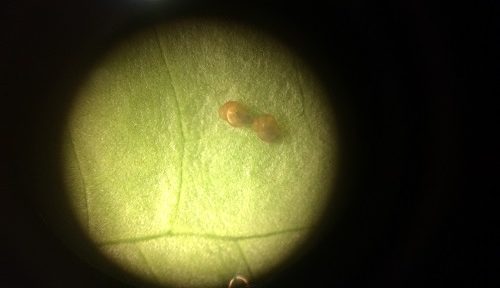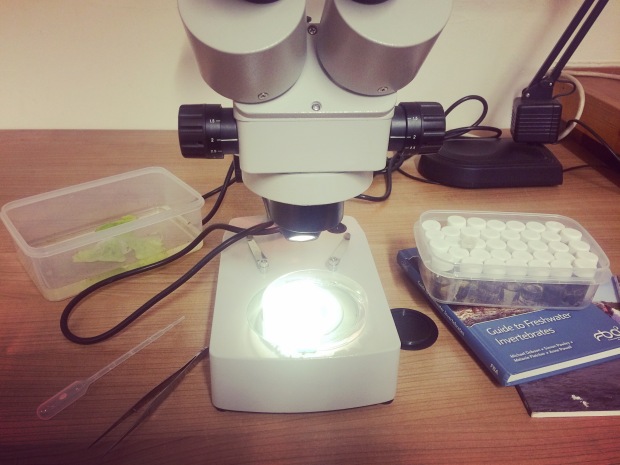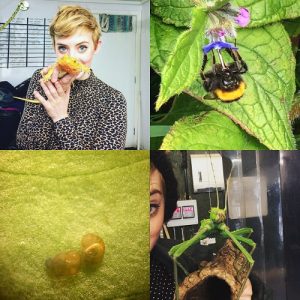
I’m Kirsty, one of six new TCV Natural Talent trainees for this year. For the next 365 days I’ll be training up on all things invertebrate at Buglife Scotland.
TRAINEESHIP
This year has been the start of a new adventure for me. I moved from my job at the Zoological Society of London back home to Scotland. While studying MSc Wildlife Biology and Conservation as a part-time distance learner at Edinburgh Napier, I set out to look for a job in a related field and gained one of The Conservation Volunteers (TCV) traineeships, working with Buglife Scotland. I will be focusing on freshwater invertebrates and in particular their Pond Mud Snail Project – Marvellous Mud Snails. Over the course of the year I will be posting regular updates of all the things I’ll be getting up to here, and on my own personal blog.
So, who am I working for? Buglife, the leading organisation in Europe who are dedicated to the conservation of all invertebrates. That is, the ongoing conservation of all the little things most people go around trying to swap/stamp on/spray away if they come across one in their house. Working with the rarest and most diverse creatures in the country, I’ll be based at Buglife Scotland in Stirling. A huge part of this (and the main ethos of The Conservation Volunteers who run the traineeships each year) is to inspire and spread more awareness. By providing training opportunities for the trainees like myself , I’ll be able to use my new knowledge and skills to encourage others to get involved in conservation and citizen science in any way they can. There will be lots of opportunities to work on my practical conservation with a view towards putting together my own invertebrate focused project and event in the second half of the year.
MY MARVELLOUS MUD SNAILS
Who – The Pond mud snail (Omphiscola glabra) currently only found to be at 5 sites across Scotland in local council areas of North Lanarkshire, East Dumbartonshire, West Lothian, Clackmannanshire and the Scottish Borders. Typically 12-20mm these tiny freshwater friends are often over-looked. Pond snails keep a low profile and O. glabra are able to bury into the mud when their temporary pond habitat dries up, becoming inactive until there is water again. Like many other molluscs, the Pond mud snail is a hermaphrodite and each individual is capable of laying 10-30 eggs in February which take around 25 days to hatch. In captivity they will lay all year round, making them an excellent species to engage with the public.
What – The project has three main aims: in captive breeding & release through citizen science, public awareness & active learning in schools, and to reassess the current population. This two year project will focus on the natural heritage of the mud snail, historically widespread in lowland areas of England, Wales and as far north in Scotland as Perth. However the situation appears to be under-recorded and with significant loss of habitat and lack of management, the pond mud snail has been allowed to slide. This near forgotten important freshwater invertebrate is key to our ecosystem and in need of some help.
For captive breeding the aim is, that by the end, the current number of sites will have increased to at least 20, with citizen science and public engagement having also increased. As a TCV Natural Talent trainee, I will be helping schools in the local council areas where the Pond mud snail is currently found. Alongside work with community and volunteer groups, and helping out with extensive surveying, I’ll be regularly visiting the schools getting the kids involved with freshwater invertebrate ID and hopefully encouraging them to get excited about sharing a space with this sought-after Scottish celebrity.
Where – In nutrient poor water in marshes, ditches, and pools with few other aquatic animals. Decline in the population is due to these temporary habitats being lost or degraded through infilling. Many sites have been improved visually for landscape purposes, are affected by scrub encroachment and agricultural run off or are simply under-recorded. Surveys in 2005-6 indicated a high decline of at least 64% for historical sites in Scotland and so the reassessment is vitally needed.
Why – Its presence at a site is important and indicates water and habitat quality. The small, temporary and nutrient poor pools that Pond mud snails prefer are rarely protected and are seen as inferior habitats that are difficult to manage. These support other scarce species such as the Oxbow diving beetle (Hydroporus rufifrons) that, like the Pond mud snail are specially adapted to survive periodic drought by burying into the mud.
How you can get involved – Keep an eye out over the year for lots of upcoming events across local council areas. If you want to volunteer to be a part of the project, whether helping with captive breeding or as a practical conservation volunteer to create new homes for our Pond mud snails then get in touch – 01786 447504.
ANYTHING YOU CAN DO I CAN DO BETTER…
All molluscs are pretty amazing. In particular though I’ve been finding out a lot more about the Pond mud snail, and there’s definitely some cool things you should know.
- Walk on water: I could spend hours watching these guys clinging to the underside of the water surface, breathing with a mucus band and essentially appearing to walk on water. As (lung breathing) gastropods, the pond mud snail is able to take in air at the surface, holding on to the underside by way of surface tension, breathing the oxygen while doing so. While they’re at it they’re even able to eat pond matter and algae.
- Hermaphrodites: Like all pond snails, O glabra, will either assume the role of male or female for reproduction, and are capable of self-reproduction in the case of having to quickly repopulate a new area, such as a new pond
- Eye eye: Do I belong on land or water? There’s a quick way to tell the difference – one pair or two. Aquatic snails, like the Pond mud snail have only one pair of tentacles that are not retractable and at the base of which the eyes are placed. This group is know as Basommatophora or base-eye snails. The largest group of land snails are known Stylommatophora, literally the stalk-eye snails whose eyes are visible right at the tip of a second, longer, pair of tentacles, all of which can be withdrawn.

1 week old O. glabra under the microscope, you can just see the black dots of their eyes. Juvenile snails are much more translucent for the first months of their life than the adults until the shell takes on its dark brown colour.
LIFE IN A SHELL, SNAIL DIARY // HIGHLIGHTS WEEK 1 & 2
Week 1
17th April, Day 1 – A good way to start in a quiet office on Easter Monday, I got to meet the snails which were located from one of the 5 known sites in Scotland for the captive breeding programme beginning later this year. Together with my manager Suzi, we cleaned them out, giving fresh tasty lettuce and separated the 4 adults from the 5 week old and 1 week old little ones. There were lots of egg cases waiting to hatch which looked well on their way, I hope to monitor their progress to get an estimate of the time taken to hatch in captivity. Today was a great day to meet them team as we went on a lunchtime walk up to Stirling Castle and then it was back to the office for me to do some background reading.

View on our walk up to Stirling Castle
18th April, Day 2 – In the morning the department met with Ben Harrower, Conservation Programme Manager at RZSS, who are keen to help out with the breeding programme and can offer brilliant support looking at the genetics of the mud snails. The afternoon was taken up with ‘kid in a candy store’ style browsing of all the amazing training courses I’m able to book on to as part of the traineeship, my calendar is quickly filling up!
20th April, Day 4 – Introduction to Pond Dipping this morning, as hopefully throughout the course of the year I’ll be helping and leading my own at various events. Out in the sunshine, by dipping into the office garden pond I managed to take a look at some Ramshorn snails, whirligig beetles, flatworm, hog louse, water beetles.


Back indoors it was time to get to grips with the microscope for the first time, looking at specimens – damselfly nymph, pond skater, water beetle larvae, and of course my own mud snails under the scope. At around 1 week old, this was a chance to see them moving and being much more active than I ever had before. For the babies I was looking at them feasting on some lettuce, and being able to watch them eat was fantastic, magnified I could take a look at their different body parts at the juvenile stage, and got pretty excited about spotting their dot-like microscopic eyes. For the adults, a chance to see the intricate markings and details of the elongated shell close up and to take a better look at anatomy.

Week 2
25th April, Day 2 – TODAY THE EGG CASES HATCHED! More teeny tiny snails to look after. I’m finding I’m becoming so protective and attached to the growing snail family. It was time for a clean today and for new food to be provided, with all the new additions I had to be careful none of the little ones made an escape down the sink. You can see in the photos where the old cases have burst open, and the tiny brown dots all along the edge of the tub which are our newly hatched snails.
Until next time,
-Kirsty
Be sure to follow what I’m up to on Twitter, and check out TCV Natural Talent for an update on my fellow trainees.
Thanks to the Esmée Fairbairn Foundation for funding this brilliant programme. Find out more about them here.
Also to Buglife Scotland for hosting my placement. Keep up with all the amazing work they are doing and support the small things!






